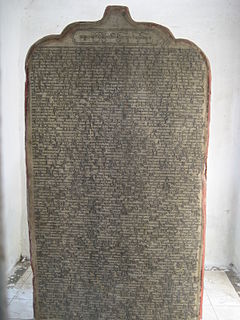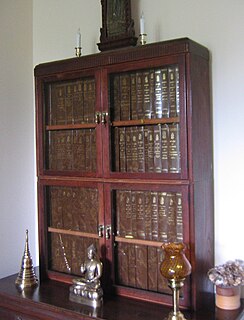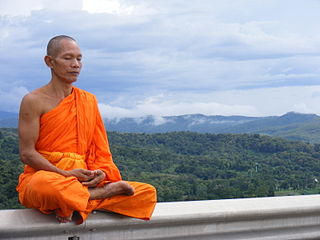
Pāramitā or pāramī (Pāli) is "perfection" or "completeness". While, technically, pāramī and pāramitā are both Pāli terms, Pali literature makes far greater reference to pāramī.

Buddhaghosa was a 5th-century Indian Theravada Buddhist commentator, translator and philosopher. He worked in the Great Monastery (Mahāvihāra) at Anurādhapura, Sri Lanka and saw himself as being part of the Vibhajjavāda school and in the lineage of the Sinhalese Mahāvihāra.

Buddhist texts were initially passed on orally by monks, but were later written down and composed as manuscripts in various Indo-Aryan languages which were then translated into other local languages as Buddhism spread. They can be categorized in a number of ways. The Western terms "scripture" and "canonical" are applied to Buddhism in inconsistent ways by Western scholars: for example, one authority refers to "scriptures and other canonical texts", while another says that scriptures can be categorized into canonical, commentarial and pseudo-canonical. Buddhist traditions have generally divided these texts with their own categories and divisions, such as that between buddhavacana "word of the Buddha," many of which are known as "sutras," and other texts, such as shastras (treatises) or Abhidharma.

The Mahavamsa is an epic poem written in the Pali language. It relates the history of Sri Lanka from its legendary beginnings up to the reign of Mahasena of Anuradhapura covering the period between the arrival of Prince Vijaya from India in 543 BCE to his reign. It was composed by a Buddhist monk at the Mahavihara temple in Anuradhapura about the fifth century A.D.

Theravada Buddhism is the State religion of Sri Lanka practiced by 70.2% of the Sri Lanka's population. Buddhism has been given special privileges in the constitution and also declared country's official religion by 2nd president of sri Lanka J.R Jayawardene. Sri Lanka is traditionally oldest religious Buddhist country where Buddhist aryan culture is protected and preserved. The island has been a center of Buddhist scholarship and learning since the introduction of Buddhism in the third century BCE producing eminent scholars such as Buddhaghosa and preserving the vast Pāli Canon. Throughout most of its history, Sri Lankan kings have played a major role in the maintenance and revival of the Buddhist institutions of the island. During the 19th century, a modern Buddhist revival took place on the island which promoted Buddhist education and learning. There are around 6,000 Buddhist monasteries on Sri Lanka with approximately 15,000 monks.

The Theragatha (-gāthā), often translated as Verses of the Elder Monks, is a Buddhist text, a collection of short poems in Pali attributed to members of the early Buddhist sangha. It is classified as part of the Khuddaka Nikaya, the collection of minor books in the Sutta Pitaka. A similar text, the Therigatha, contains verses attributed to early Buddhist nuns.

The Therigatha (Therīgāthā), often translated as Verses of the Elder Nuns, is a Buddhist text, a collection of short poems of early women who were elder nuns. The poems date from a three hundred year period, with some dated as early as the late 6th century BCE. In the Pāli Canon, the Therigatha is classified as part of the Khuddaka Nikaya, the collection of short books in the Sutta Pitaka. It consists of 73 poems organized into 16 chapters. It is the companion text to the Theragatha, verses attributed to senior monks.

The brahmavihārās are a series of four Buddhist virtues and the meditation practices made to cultivate them. They are also known as the four immeasurables. The Brahma-viharas are:
- loving-kindness or benevolence (metta)
- compassion (karuna)
- empathetic joy (mudita)
- equanimity (upekkha)
Pali literature is concerned mainly with Theravada Buddhism, of which Pali is the traditional language. The earliest and most important Pali literature constitutes the Pāli Canon, the scriptures of Theravada school.
Aṭṭhakathā refers to Pali-language Theravadin Buddhist commentaries to the canonical Theravadin Tipitaka. These commentaries give the traditional interpretations of the scriptures. The major commentaries were based on earlier ones, now lost, in Prakrit and Sinhala, which were written down at the same time as the Canon, in the last century BCE. According to Theravada tradition, the major commentary were authored by five hundred senior monks at the First Buddhist council. Some material in the commentaries is found in canonical texts of other schools of Buddhism, suggesting an early common source.
The Udana (udāna) is a Buddhist scripture, part of the Pali Canon of Theravada Buddhism. It is included there in the Sutta Pitaka's Khuddaka Nikaya. The title might be translated "inspired utterances". The book comprises 80 such utterances, most in verse, each preceded by a narrative giving the context in which the Buddha utters it.
The Nettipakarana is a Buddhist scripture, sometimes included in the Khuddaka Nikaya of Theravada Buddhism's Pali Canon. The main theme of this text is Buddhist Hermeneutics through a systematization of the Buddha's teachings. The Sri Lankan scholar Dhammapala wrote a commentary on this text in the fifth century. An English translation titled The Guide by Bhikkhu Nanamoli was published in 1962 by the Pali Text Society.
The sub-commentaries are primarily commentaries on the commentaries on the Pali Canon of Theravada Buddhism, written in Sri Lanka. This literature continues the commentaries' development of the traditional interpretation of the scriptures. These sub-commentaries were begun during the reign of Parākramabāhu I (1123–1186) under prominent Sri Lankan scholars such as Sāriputta Thera, Mahākassapa Thera of Dimbulagala Vihāra and Moggallāna Thera.
Prajnalok Mahasthavir (1879–1971) was a scholar, writer and orator of Pali and a preacher, educationist and writer of Buddhism.

Lance Selwyn Cousins, was a leading scholar in the field of Buddhist Studies. Born in Hitchin, Hertfordshire, he studied history and oriental studies at Cambridge University, and took up a post in the Department of Comparative Religion at Manchester University as lecturer and then senior lecturer. After early retirement in the 1990s he settled in Oxford and continued to publish scholarly papers and reviews including a widely cited historical summary such as "The Dating of the Historical Buddha: A Review article," which was published in The Journal of the Royal Asiatic Society. He was a Fellow at Wolfson College University of Oxford and part of the faculty at the Oxford Centre for Buddhist Studies. Prior to this, he was briefly President (2002/3) of the Pali Text Society (PTS). Professor Richard Gombrich once described him as the leading authority in the West in the field of abhidhamma.
The term "paracanonical texts" is used by Western scholars to refer to various texts on the fringes of the Pali Canon of Theravada Buddhism, usually to refer to the following texts sometimes regarded as included in the Pali Canon's Khuddaka Nikaya:

The Pāli Canon is the standard collection of scriptures in the Theravada Buddhist tradition, as preserved in the Pāli language. It is the most complete extant early Buddhist canon.

The Thūpavaṃsa is a Sri Lankan historical chronicle and religious text recorded in the Pali language. It's composition is attributed to a Buddhist monk known as Vācissara, the putative author of several Pali and Sinhala commentaries and handbooks. It was likely composed in the second half of the 13th Century.











